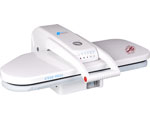Heat Setting Fabric Inks
Modern water based fabric screen printing inks (Aquatex and Permaset Aqua) require heat setting to activate the pigments and bond them to the fabric. It's a critical part in finishing your printing process and if not performed will leave your design faded and poor quality over time. The temperature used should be the hottest the material can withstand, without scorching or burning the material.
You can heat set immediately after you have printed the design, however the ink is still wet and you will need to cover it with a piece of paper to stop is blurring/ marking your equipment - it's really still too messy at this stage so wait 30 mins until it's touch dry. You will still need to cover the design with brown paper when heat setting as although touch dry, the print remains 'wet' for up to 48 hours.
The best way to heat set is by leaving your designs naturally air dry for as long as possible (2-3 days) as this will allow most of the water medium to naturally evaporate and greatly speed the setting process. Then when dry, come back and heat set with most of the water based medium gone, your print comes up to temperature much quicker and as there's little to no medium to evaporate you can skip straight to the actual pigment activation process the heat setting provides, bring your setting down from over 2 mins. to around 45 seconds*.
What happens if you don't heat set?
Unless the print was performed under 15 minutes ago, the ink will not wash out. If you don't heat set, when washed the print will fade slightly with black turning into a lighter shade - the design does not disappear, but looks worn and will continue to fade on each subsequent wash.
What can I use to heat set?
The temperature required must be hot enough to firstly evaporate the water based medium, then set the pigments (minimum 150°C depending on the material to be heat set), a household iron, Fabric Ink Setting Heat Press or commercial tunnel dryer are recommended.
Household iron - Use highest setting fabric allows
Fabric Ink Setting Heat Press - Usually heat set at 180°C for at least 30 seconds
Sun or outside clothes line - Can not be used as temperature is not hot enough.
Commercial Tunnel Dryer - 120°C degrees for 6 minutes, 160°C degrees for 3 minutes, 180°C for 2 minutes
Air Dry - Only suitable for use where Poly Prop Additive has been used.
Household clothes dryer - Can not be used as temperature is not hot enough.
Flash Exposure Unit - Not Suitable as this is a U.V. system for solvent and plastisol inks only.
Hand held hair drier - Can not be used as temperature is not hot enough.
Commercial Dryer (Laundromat) - Not a recommended method as temperature is not accurate and time limit can vary greatly on garment type. Garments left in too long may shrink or be damaged.
We recommend using Fabric Ink Setting Press for a number of reasons to speed your ink setting and make the overall process easier and cheaper.
Pressing surface 10 times the size of regular irons
 Commercial element - 1600-Watts of power
Commercial element - 1600-Watts of power
Non stick surface made out of Teflon
Works for all types of clothing
Extra large 32" x 10" pressing board
100 Pounds Pressing Pressure
Portable and easy to store
Do all inks I print need to be heat set?
All inks need to be set or cured in some form, water based Aquatex Fabric inks require heat.
Not all inks require heat for setting, e.g. Aqua inks for metal/ plastic air dry in 48 hours, ceramic inks must be fired in a kiln, solvent inks generally require U.V. flash curing, etc. Always read the manufacturers instructions on the ink bottle.
The setting process
The length of time required to heat set the ink depends on the temperature of the iron (this is set by the garment you are setting) and the size of the print area. The following is a guide to the heat setting process and explains why prints should be heat set for 2 minutes to ensure permanent bonding.
66°C [150F] Water begins to leave the ink
94°C [200F] Binder reaches lowest viscosity and maximum surface contact is made with the fabric
105°C [220F] Water begins to leave the ink rapidly - shown as steam coming up from the design
133°C [270F] Fifty percent of the water is gone and the binder and pigment start to cure
150°C [300F] Most of the water is gone and the binder-pigment combination is partially cured
150°C [300F] For 30 seconds to a minute - binder and pigment is cured
The above should be used as a guide only, and will vary slightly between ink types.
Note most times printed on sides of containers are for wet prints.
Curing of dry prints still takes at least 2 minutes as ink has to get to temperature first.
Heat setting is faster when you can let the design naturally dry for 24 hours/ overnight as some natural evaporation will occur and shorten the heat setting process.
Technique
Firstly you must ensure you do not overheat the garment and scorch/ mark the fabric so do not set the iron to cotton if you are heating lycra. The temperature you set the garment at is limited by the material.
Where the setting must be lowered, the time to set must be increased to compensate.
It is best to use brown paper over the design to ensure no marks are transferred onto the garment when heat setting (not all irons bases are clean). Brown paper will also help to distribute the heat more evenly and reduce scorching.
Pass the iron over the design from one side to the other ensuring you do not hold it still in any area, or scorching may occur.
Where force drying is used to speed the touch dry process, ensure the temperature does not exceed the limitations of the material.
Setting Aqua Ink for Plastic/Metals
Aqua Inks (plastic/ metals) and do not require heat setting as they will dry naturally and cure over 24-48 hours.
The ink can be force dried with a hair drier to make touch dry, however touch dry is not 'cured' and the ink may still scratch off or be removed in under 24 hours.
* Always test the setting times before use. Heat setting is normally complete 30 seconds after any steam (this is the water based medium evaporating) has stopped.

